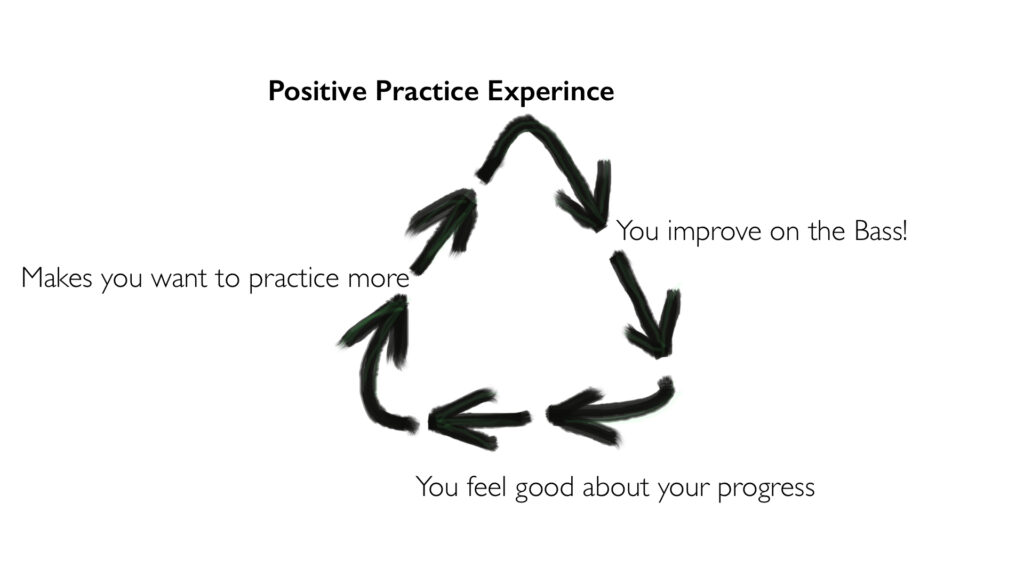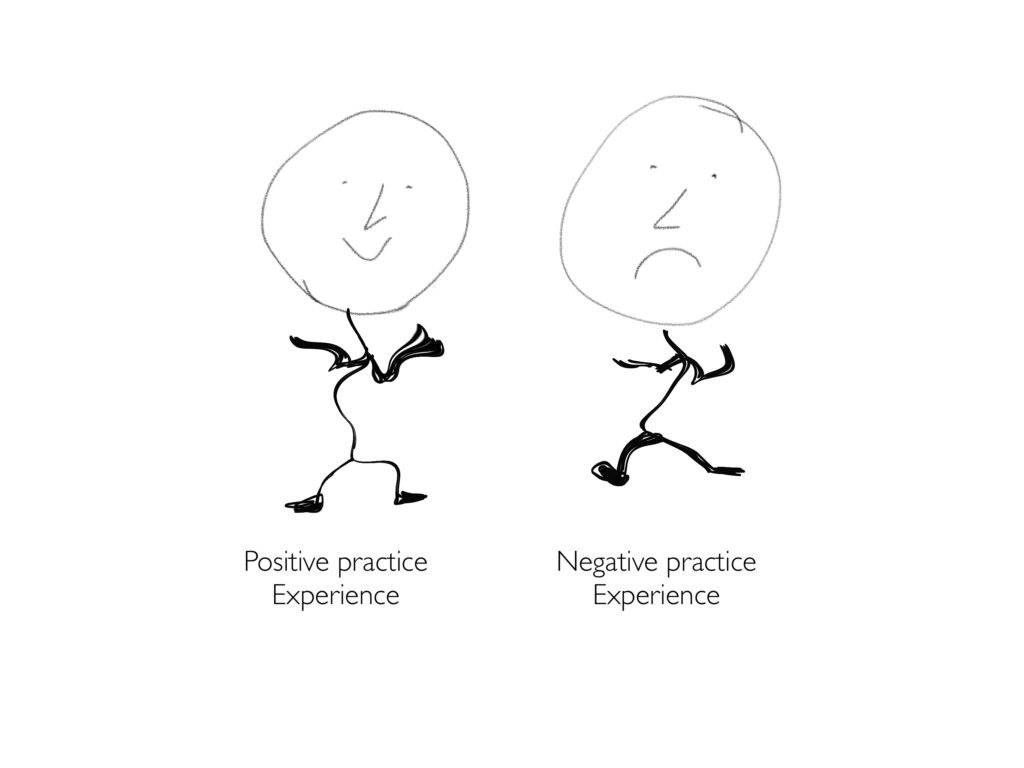I was reminded recently that a lot of bass players struggle to come up with a satisfying practice routine. They just simply don’t know how to have an awesome practice experience on the bass.
Many students I encounter tend to approach their practice time in a less structured way. This unfocused type of practice just doesn’t work, it produces a lack of clarity and no feeling of progress. As we are learning things, we want to make progress, we want to feel like we are making progress, it’s natural to want to feel that way. This feeling of progress is the fuel that will drive your practice time!
Do you know How To Have An Awesome Practice Experience On The Bass?
How you practice is how you play! You’ve probably heard this before but just think about it for a moment. The way you practice can have a positive or negative effect on your overall playing. What I’m hoping to do is to help move you into a positive direction so that your practice time will become the fuel that excels you to play better and practice more.

One of the cool things about music is that we don’t have to all learn the material in the exact same way. There are different paths to learning the same information. Some people will prefer to practice in the same order and process each time while others will like more variety in their practice routine. This will take a little bit of self evaluation and trial and error for you , but in the end, you will come up with a great practice routine.
Journaling
When we are talking about journaling in music we aren’t talking about writing about your feelings, but rather keeping track of your progress (although you can write about your feelings if you want).
This can become a great visual reminder of the progress you are making. If you started out playing your scale at 90 bpm but have moved it up to 120 over a couple of weeks then you are making progress. Being able to look at this, and visually see your progress is also rewarding.
Elements of Practice
- Physical warm up
You will want to start off your practice time with some warm ups. A great warm up before playing are shoulder circles, going forward a little and then backwards. It will start to warm up your hands and get the blood flowing. - Musical warm up
Your musical warm up can be a technical exercise, scales, arpeggios, or any other musical figure you can play. Pick a moderate speed for you and play through your exercise for a few minutes to warm up your hands and prepare for your practice time. - Maintenance
Once you are warmed up, it is a good idea to continue to warm up by practicing your scales and arpeggios. Remember when you are practicing, you want to engage your mind as well as your hands in what you are doing. If you find yourself zoning out, then it’s time to try a different root movement. There are numerous root movements that will add interest and variety to what you are doing. . You can play through your scales chromatically, around the circle of fourths, up in whole steps, up in minor thirds, etc…. Really, the possibilities are endless! - Technique
Work on any technique stuff here (slapping, double thumping, tapping, etc……). A word of caution: don’t get stuck here. - Music and Free Play
Try and spend at least half of your practice time working on music or free play. Reading music, playing bass lines, memorizing a tune, working on soloing, or….really anything music related should go in this section. Free play is just self exploration on your instrument and is crucial for most people to improve.
How to Use The Metronome
There are numerous ways to use the metronome. I want you to think of each of these as a process or sequence. As soon as you get one down, move onto the next one and continue until you are comfortable with all of these. If you don’t have a metronome to practice then I suggest this one or this one here.
- Quarter notes
When you first start out, I recommend putting the metronome on quarter notes and playing your exercises with quarter notes. Don’t go too fast, your goal in the beginning is accuracy not speed. The speed will come, just be patient. - Eighth notes
Once you are comfortable with this, you should keep the metronome on quarter notes but play eighth notes. You don’t have to go twice as fast to play eighth notes. For example, if you are playing a major scale at quarter=160 bpm and you want to give eighth notes a try. Put your metronome on quarter=80 and then you play eighth notes, or twice as fast as your metronome is beating. You will be playing the same speed as before but the metronome will only click on the downbeats. - Playing on 2 & 4
Once you are comfortable with that, you should put your metronome so that it is beating only on 2 and 4. Sometimes this can be tricky when you first try this. I suggest thinking of a drum beat, and imagine the snare drum (which typically will play on 2 & 4). Practicing in this manner will help you to be more responsible for time, which will help you to groove better and to play with a stronger sense of time. - Groovin’
Using the metronome to help you develop a stronger sense of time is what we will be working on here. The basic idea is we are going to take eighth notes or sixteenth notes and come up with a rhythm (using just a couple of notes to start with) until this rhythm is internalized.
Groovin’ Examples
You should get a small chalkboard or whiteboard that you can keep close by so you can visualize what you are trying to do. By incorporating a visual representation of what you are doing, it will help you to internalize the rhythm easier.
Here is an example using eighth notes. In this example you would want to play your groove using only the rhythm from the notes in bold.
- 1 & 2 & 3 & 4 &
Once you get this previous groove down then choose another rhythm to conquer. Here are some other 1/8th note examples
- 1 & 2 & 3 & 4 &
- 1 & 2 & 3 & 4 &
Remember to play with a metronome or drum machine until you internalize each of these. If you can play the rhythm and easily play fills then you have internalized it. If playing the fills makes you lose the groove, you need to keep working on it.
Once you are comfortable you should move on to 1/16th notes.
- 1 e & a 2 e & a 3 e & a 4 e & a
This is really a fun way to practice and it will improve your internal sense of time quite a bit. You don’t have to limit yourself to only two notes per groove, but if you have never practiced this way before I would suggest starting off simpler with just two or three notes.

Some Sample Practice Routines
Beginner
- 30 seconds of shoulder circles 2 minutes – 1234 warm up (left hand fingering) on G string, start on the 1st fret play the pattern 2x then move up one fret
- 5 minutes – play major scale pattern with metronome on E&A strings moving one fret at a time
- 10 minutes – work on a bass line, reading, drum machine, or metronome
- 5 minutes – free play
Intermediate
- 30 seconds – shoulder circles 2-3 minutes – one octave Major 7 arpeggios ascending chromatically on E and A strings
- 10 to 15 minutes – play through all modes around circle of fourths
- 5 to 10 minutes – play all arpeggios around circle of fourths
- 20 to 30 minutes – work on bass line, reading, and groovin’
- 10 to 20 minutes – free play
PDF’s
- There are supporting PDF’s for this post in the Bass Toolkit Area.
Hope you enjoy these Practice ideas…
PDF Bass Clef & Tab versions are in theBass Toolkit Area
Not a member already?
Sign up for Free!
